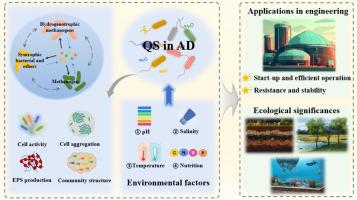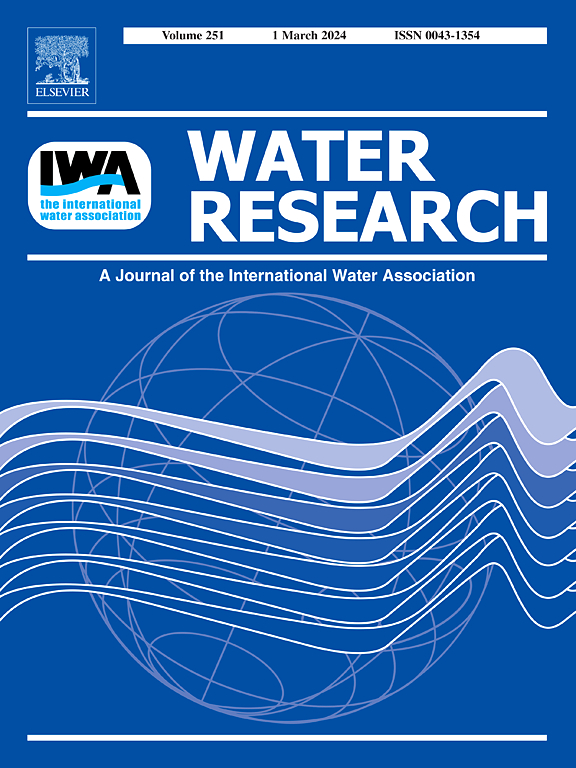Roles and opportunities of quorum sensing in natural and engineered anaerobic digestion systems
IF 11.4
1区 环境科学与生态学
Q1 ENGINEERING, ENVIRONMENTAL
引用次数: 0
Abstract
Anaerobic digestion (AD) is a biological process in which anaerobic microorganisms convert organic matter into methane-rich gas, contributing to the cycling of carbon and other nutrients. Quorum sensing (QS), a microbial communication mechanism, plays a critical role in regulating population-level behaviors within AD systems. This review systematically examines the roles and applications of QS in AD, emphasizing its importance in enhancing process efficiency. The review begins by exploring the pathways and characteristics of QS in key functional microorganisms involved in AD. We analyze the response mechanisms of QS to key environmental variables and their effects on the structure and function of microbe communities and extracellular polymeric substances secretion. Potential applications of QS in engineered AD systems are discussed, with a focus on promoting system startup, improving operational efficiency, and enhancing resistance and stability. The use of exogenous signaling molecules and quorum quenching reagents to optimize AD performance is also evaluated. Additionally, the ecological significance of QS in natural environments, such as seafloor sediments and wetlands, is explored, emphasizing its role in regulating AD-related microorganisms within complex microbial communities. Finally, the review identifies current knowledge gaps and outlines future research directions in AD, including QS database development, QS-engineered bacteria excavation, and advanced analytical methods assistants. This comprehensive review aims to bridge existing gaps in QS-related knowledge in AD and provide fresh perspectives for studying microbial communication and collaboration through QS.

群体感应在自然和工程厌氧消化系统中的作用和机会
厌氧消化(AD)是厌氧微生物将有机物转化为富含甲烷的气体,促进碳和其他营养物质循环的生物过程。群体感应(Quorum sensing, QS)是一种微生物通讯机制,在AD系统中调控种群水平的行为起着至关重要的作用。本文系统介绍了QS在AD中的作用和应用,强调了其在提高工艺效率方面的重要性。本文首先探讨了AD中涉及的关键功能微生物中QS的途径和特征。我们分析了QS对关键环境变量的响应机制及其对微生物群落结构和功能以及胞外聚合物质分泌的影响。讨论了QS在工程AD系统中的潜在应用,重点是促进系统启动,提高运行效率,增强阻力和稳定性。使用外源信号分子和群体猝灭试剂来优化AD性能也进行了评估。此外,还探讨了QS在海底沉积物、湿地等自然环境中的生态意义,强调了其在复杂微生物群落中调控ad相关微生物的作用。最后,综述指出了目前的知识差距,并概述了未来的研究方向,包括QS数据库的开发、QS工程细菌的挖掘和先进的分析方法辅助。本文旨在弥补AD中QS相关知识的空白,为微生物通过QS进行交流与协作提供新的研究视角。
本文章由计算机程序翻译,如有差异,请以英文原文为准。
求助全文
约1分钟内获得全文
求助全文
来源期刊

Water Research
环境科学-工程:环境
CiteScore
20.80
自引率
9.40%
发文量
1307
审稿时长
38 days
期刊介绍:
Water Research, along with its open access companion journal Water Research X, serves as a platform for publishing original research papers covering various aspects of the science and technology related to the anthropogenic water cycle, water quality, and its management worldwide. The audience targeted by the journal comprises biologists, chemical engineers, chemists, civil engineers, environmental engineers, limnologists, and microbiologists. The scope of the journal include:
•Treatment processes for water and wastewaters (municipal, agricultural, industrial, and on-site treatment), including resource recovery and residuals management;
•Urban hydrology including sewer systems, stormwater management, and green infrastructure;
•Drinking water treatment and distribution;
•Potable and non-potable water reuse;
•Sanitation, public health, and risk assessment;
•Anaerobic digestion, solid and hazardous waste management, including source characterization and the effects and control of leachates and gaseous emissions;
•Contaminants (chemical, microbial, anthropogenic particles such as nanoparticles or microplastics) and related water quality sensing, monitoring, fate, and assessment;
•Anthropogenic impacts on inland, tidal, coastal and urban waters, focusing on surface and ground waters, and point and non-point sources of pollution;
•Environmental restoration, linked to surface water, groundwater and groundwater remediation;
•Analysis of the interfaces between sediments and water, and between water and atmosphere, focusing specifically on anthropogenic impacts;
•Mathematical modelling, systems analysis, machine learning, and beneficial use of big data related to the anthropogenic water cycle;
•Socio-economic, policy, and regulations studies.
 求助内容:
求助内容: 应助结果提醒方式:
应助结果提醒方式:


